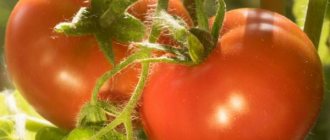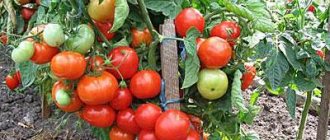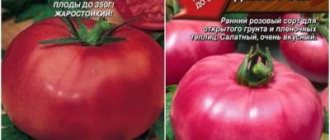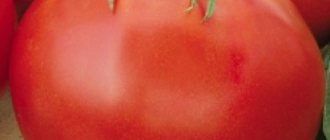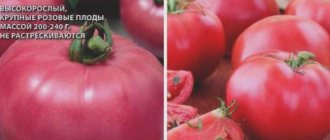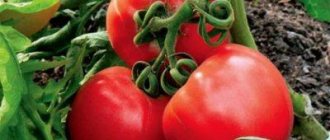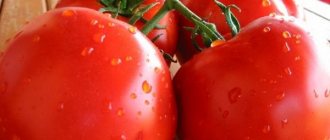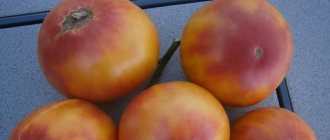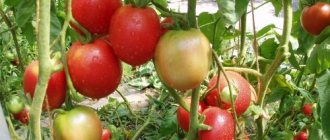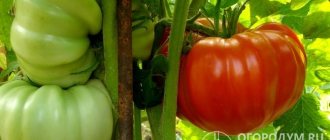Description of tomato Chelyabinsk meteorite
Information about the Chelyabinsk meteorite variety has been present in the state register since 2015. It can be grown in all regions of Russia. The author is the famous breeder Myazina L.A. Tomatoes ripen early. The plant is determinate, 150–180 cm high. The leaves are dark green, large, reminiscent of potato tops. Inflorescences of a simple type. Tomatoes ripen in clusters of 5–7 pieces.
Description of fruits
Description of tomato fruits of the Chelyabinsk meteorite variety:
- flat-round shape;
- medium density pulp;
- orange-red color;
- weight up to 300 g;
- number of nests from 4 to 6;
- good sweet taste.
Characteristics of the variety
Before choosing tomatoes for planting, it is important to take into account all the characteristics of the variety. Pay attention to the timing of fruiting, yield, resistance to diseases and climatic factors.
Productivity and fruiting
Tomatoes of the Chelyabinsk meteorite variety ripen early: at the beginning and end of July. Fruiting is extended, until the onset of frost.
According to the description, Chelyabinsk meteorite tomatoes yield 12–12.5 kg per 1 sq. m. Productivity per plant is about 4 kg. The variety is planted in greenhouses and open areas. Watering and fertilizing have a positive effect on fruiting. Tomatoes are resistant to adverse conditions and form ovaries even in cold and rainy weather.
Area of application of fruits
The purpose of the fruit is universal. They are used fresh in cooking. Thanks to their thick skin and medium size, tomatoes are suitable for pickling and pickling for the winter.
Resistance to diseases and pests
The variety is resistant to major diseases and crop pests. Requires preventive treatments and adherence to agricultural technology.
Advantages and disadvantages of the variety
The tomato variety Chelyabinsk meteorite has a number of positive characteristics:
- early maturation;
- high productivity;
- presentation of the fruit;
- resistance to adverse conditions, diseases and pests;
- good taste.
The variety has no obvious disadvantages. High humidity may cause the fruit to crack.
Unpretentious varieties of tomatoes
[/td]
Unpretentious tomatoes for the Urals and Siberia are characterized by excellent resistance to frost, which is possible even in summer, resistance to diseases, as well as stable yield, regardless of growing conditions.Sanka
The variety is undemanding in care and produces an excellent harvest, which is why it has gained popularity among gardeners. There are two types of this determinate variety with small red or yellow fruits. A low-growing bush, reaching a maximum height of 60 cm, strewn with clusters of aromatic and fleshy tomatoes. This is an extremely early variety. Fruit ripening occurs 75–85 days after germination and bears fruit until frost. 7–8 tomatoes will ripen on one bunch at once. In the ground, the fruits of this tomato reach 100 g, when grown in a greenhouse - 150 g. They have a dense skin, the flesh is fleshy and juicy with an excellent taste (which contains a slight sourness). They have an excellent presentation. They tolerate transportation well and have increased shelf life. The variety belongs to salad and pickling varieties. “Sanka” “golden” has a high carotene content, so it is suitable for dietary and baby food. The variety is resistant to temperature changes, cold-resistant, shade-tolerant and has immunity to tomato diseases, including late blight.Explosion
The “Explosion” tomato belongs to the early-ripening hybrid varieties, since from the moment the seeds are planted in the ground until the ripe fruit appears, 100 to 110 days pass. Determinate bushes of this tomato grow up to 45-60 centimeters and are not standard. They are characterized by spreading nature. These tomatoes can be grown both in open ground and in greenhouses. It is highly resistant to changes in weather conditions, as well as to most diseases. About 3 kilograms of fruit are usually harvested from one bush of these tomatoes. These tomatoes have a round, slightly ribbed shape and weigh from 120 to 260 grams. They have a dense consistency and red color. “Explosion” tomatoes can be stored for a long time and tolerate transportation well. Tomatoes of this variety are ideal for fresh consumption and preparing vegetable salads, canning and pickling, pickling, making ketchup, tomato paste and juice.Mystery
Determinate type bush with a very powerful trunk. The number of leaves is average, the usual size and color for a tomato. It is distinguished by a compact, low bush, reaching a height of 45-50 centimeters when planted in open ground. In the greenhouse it is 10 centimeters higher. The tomato stands out from the general row due to its ultra-earliness. The shape of the fruit is round, slightly ribbed near the stalk. The color of the tomato is bright red. The average weight of the fruit is 75-95 grams in open ground, 100-110 g in greenhouse conditions. Productivity is average. When planting 6-8 bushes per square meter, you can get 20-22 kilograms of fruit.Shuttle
The ideal variety is undemanding and productive, producing tasty and juicy fruits throughout the season. It is recommended to plant under film or in a greenhouse. In closed ground conditions, fruiting lasts until frost. Compact bushes can be planted in pots and flowerpots and placed on loggias and window sills. The harvest is well stored and tolerates transportation well. The bush is determinate, very compact, standard type. The size of an adult plant does not exceed 50 cm. The amount of green mass is average; the bush does not require formation. The fruits are elongated, cylindrical in shape, with a pointed tip, resembling a sweet pepper in shape. The weight of each tomato is 50-60 g. The fruits are very juicy, pleasantly sweet, and fleshy. The glossy, dense skin protects the tomatoes from cracking. The high sugar content makes the fruits suitable for baby food.Black Moor
Tomatoes "Moor" are a semi-determinate species with a mid-season ripening period; it is suitable for growing both in open and closed ground (film greenhouses). The fruits appear 115 - 125 days after the first shoots. The bushes grow up to a meter in height, in greenhouses even higher (up to one and a half meters). The first brush is formed approximately at the level of 8 - 9 leaves, and all subsequent ones are formed every 3. On one brush of a bush, 7 - 10 fruits usually appear, although in some cases this number can increase up to 18. The total yield from 1 sq. meters approximately 5 - 5.5 kg. Get ready for the rapid appearance and flowering of stepchildren, which must be trimmed. The fruits are small, weighing up to 50 g each. They have a characteristic dark red color, oblong shape and rather thick skin. However, the real distinctive feature of this variety is its taste. Fleshy, juicy and sweetish fruits are perfect for both fresh consumption and adding to salads.Kibitz
An early-ripening, determinate, super-yielding tomato variety for open ground that does not require pinching. The height of the bush is only 50 cm, the whole bush is simply strewn with fruits. A garter to the support is required. The fruits are elongated cream, dark red in color at maturity, weighing 60-80 grams, fleshy, sweet, tasty. For early tomatoes, the taste is very good. Perfect for preparations. The variety sets fruit well in any weather and does not drop flowers. Among the disadvantages: after ripening, the fruits easily fall off the bush when touched. The variety "Kibits" is not susceptible to late blight.Oak
The second name of this variety is “Dubrava”. An early-ripening, determinate, productive tomato variety for open ground. The period from germination to the beginning of fruit ripening is 85-105 days. The bush is weakly branched, medium leafy, up to 70 cm high, and does not require pinching. The fruits are round, smooth, red in color at maturity, weighing up to 110 grams, good tomato taste. These tomatoes are suitable for early fresh salads, pickling, and processing into tomato products. Advantages of the variety: high yield combined with early ripening, good resistance to late blight, excellent fruit quality.Bear Paw
Mid-season, indeterminate (unlimited growth), large-fruited tomato variety for open ground and greenhouses. The bush is powerful, with a regular tomato leaf, 1.5-2 meters high. Requires tying to the support and pinning. It is best to form 1-2 stems; if you leave more, the fruits will be noticeably smaller. The fruits are flat-round, fleshy, red in color at maturity, weighing 150-300 grams (if grown in 1 stem, they can weigh up to 500 g), not prone to cracking. The taste is very good, rich. These tomatoes have a universal purpose, as they are suitable for fresh consumption and for making juices and sauces. Advantages of the variety: heat resistance, resistance to major tomato diseases, large fruit, excellent taste. Productivity: above average.Wonder of the world
Mid-season, indeterminate, productive, tall tomato variety for greenhouses and open ground. The bush is up to 2 meters high, it is recommended to form it into 2-3 stems. On the main stem, 4-5 clusters are formed, each of which contains an average of 15-25 fruits: weighing 50-60 grams. Tomatoes have a very beautiful shape and color, very similar in appearance to small lemons. The taste is excellent; these tomatoes have a high content of beta-carotene. They are great for fresh consumption, as well as for canning.French grape
A productive, mid-season, pickling variety of determinate type, up to 1 meter high. Designed for cultivation in open ground and in greenhouses. Can be grown without pinching. Tomatoes are finger-shaped, even, smooth, dense, beautiful, bright red in color at ripeness, weighing 80-100 grams. They have good taste, excellent shelf life and transportability, and do not crack. The fruits grow in clusters, with 8-12 pieces in one cluster. The variety is very convenient for autumn preparations; canned fruits will be an unrivaled delicacy on your table. Advantages of the variety: resistance to major tomato diseases, excellent commercial quality of the fruit. Productivity: up to 3.5 kg of fruits from 1 bush (with proper agricultural technology).[td]
Growing rules
The most effective way to grow tomatoes of the Chelyabinsk meteorite variety is through seedlings. It is obtained at home and transferred to a permanent place. To obtain a high yield, tomatoes are cared for by watering, fertilizing, and forming a bush.
Planting seedlings
For seedlings, containers and substrate are prepared in advance. It is best to use boxes or containers 15 cm high. To avoid picking, seeds are planted in peat cups or tablets. The substrate is obtained by combining humus and fertile soil. Ready-made soil mixture can be purchased at a garden store.
Advice! If soil from the site is used, then it is preheated in the oven or watered with a solution of Fitosporin.
Planting work begins in March or April. The containers are washed with warm water and soap, then dried and filled with substrate. The seeds are planted in furrows 1 cm deep. A thin layer of soil is poured on top and moistened well. The containers are covered with a plastic bag to retain heat and moisture as much as possible. Tomatoes are kept in a warm and dark place. Periodically turn the polyethylene over and remove the condensation.
Tomato shoots appear within 10–14 days. The containers with the sprouts are moved to the light. During the development period, tomato seedlings of the Chelyabinsk meteorite variety are provided with several conditions:
- Temperature. During the daytime – within 20–25 °C, at night – about 18 °C.
- Lighting. Tomatoes should be exposed to light 12–14 hours a day. If the day is still short, then turn on the phytolamps.
- Watering. Moisture is added weekly and the soil is not allowed to dry out.
- Lack of cold air. Seedlings are protected from drafts. To prevent plants from suffering from the cold on the windowsill, a sheet of foam plastic is placed under the boxes.
When the tomatoes have 2 leaves, they start picking. Containers with a volume of 0.5 liters are prepared in advance. They are filled with the same substrate that was used for seedlings. The tomatoes are carefully separated and placed in separate containers. Weak plants are discarded.
Transfer
Tomatoes are ready for planting in a permanent place at the age of 45–50 days. Their height reaches 40 cm, there are 6–8 true leaves and a developed root system. 3 weeks before the proposed work, tomatoes begin to harden. This increases their immunity and resistance to adverse factors.
First, open a window in the room with tomato seedlings for 2–3 hours to ensure air flow. Then the containers are moved to the balcony. At first, the Chelyabinsk meteorite variety is covered with paper to protect it from the bright sun. Before planting, tomatoes are constantly kept in natural conditions.
The beds for the crop are prepared in the fall. Tomatoes prefer fertile, loose soil and good lighting. At the end of the season, the soil is dug up and fertilized with rotted manure. You should choose places where cucumbers, greens, cabbage, carrots, beets, garlic or onions grew a year earlier.
Attention! The place where tomatoes are grown is changed annually. It is not allowed to plant the crop immediately after potatoes, peppers and other nightshades.
Holes are prepared for tomatoes at a distance of 20–25 cm. Within 1 square. m plant no more than 3–4 plants. Leave 30 cm between them, and no more than 60 cm between rows. If you arrange the tomatoes in a checkerboard pattern, you can make care and harvesting easier.
Before planting, tomatoes of the Chelyabinsk meteorite variety are watered and carefully removed from the containers. They are transplanted with a clod of earth. If peat tablets were used, the tomatoes are transferred along with them. After planting, the plants are watered. To protect from the sun, at first they are covered with paper caps.
Aftercare
According to reviews, the Chelyabinsk meteorite tomato responds positively to care. Tomatoes are watered regularly. Before flowering, the soil is moistened every week; the bush requires 4 liters of water. When the buds begin to bloom, water is added after 3 days, the consumption rate is 3 liters. When the fruits ripen, they return to the original watering scheme.
To help tomatoes better absorb moisture and nutrients, loosen the soil after rain or watering. To do this, use a small pitchfork and try not to damage the roots of the plant. Mulching the soil helps reduce the number of waterings. A layer of straw or peat 3–5 cm thick is poured onto the beds.
Chelyabinsk meteorite tomatoes are fed 14 days after being transferred to a permanent place. Before the buds form, nitrogen fertilizers are applied to stimulate the growth of new shoots. These include infusions of mullein, nettle, solutions of urea and ammonium nitrate. When inflorescences appear, they switch to the subcortex with superphosphate and potassium salt. Add 35 g of each fertilizer to a 10-liter bucket of water. The solution is poured under the root.
Advice! Mineral fertilizers alternate with organic ones. Tomatoes are fertilized with wood ash, yeast, and sprayed with milk and honey.
The Chelyabinsk meteorite variety is formed into 1 stem. Excess stepsons are removed weekly. Pinch the top of the tomato, leaving 2 leaves above the cluster with fruit. Formation helps to normalize the yield and direct the plant’s strength to fruiting.
Tomato bushes are tied to a support so that they do not lean toward the ground. A wooden stake, pipe or metal rod is dug into the soil. Tying is done as the tomatoes grow. Use thin strips of fabric or rope.
Growing tomatoes in the Southern Urals: new varieties and tested varieties
You need to choose a variety based on the conditions of the climatic zone, taking into account the characteristics of your site. “The variety largely determines the success of the whole business,” taught I. V. Michurin.
So much has been written about tomatoes; every gardener implements something of his own when growing the crop. I will not repeat myself, but I want to draw attention to the most reliable tomatoes that will bear fruit well and produce an excellent harvest in Siberia, the Urals, and in Central and Southern Russia.
I know that many gardeners carefully “manage” tomatoes of the varieties Alpatieva, Budenovka, Vzryv, Baron, Gina Danko, Dachnik - a bush of only 40 cm, early ripening, fruits up to 180 grams. Countryman, Riddle - ultra-early ripening varieties. Yamal-200, Sub-Arctic, Wind Rose, Alaska, Russian Soul, Little Red Riding Hood, Kibits, Leader of the Beds. Early-83 is an unpretentious, early variety, friendly ripening of fruits in the bush. From germination to ripening 90 days. Height from 35 to 60 cm, without stepsons and garter. The fruits are red, weighing up to 150 grams, tasty.
Variety "Masterpiece"
Far Eastern pink is a large-fruited variety of Siberian selection. The fruits are large, pink, weighing up to 400 grams. Always productive, plant height in open ground is 1 m, and in a greenhouse it is higher.
Raspberry capsule, Siberian capsule, Demidov... All the varieties that I tested on my site and offer to you are difficult to list. Every year, I and amateur gardeners are satisfied with the tomatoes of Siberian selection.
Based on the study and testing of a large number of varieties in different climatic zones of Siberia and the Urals, it was established that only early-ripening, high-yielding, well-adapted to sudden weather changes and disease-resistant tomatoes should be bred.
Non-seedling varieties
Last season, I was pleased with the varieties planted for the first time on my plot: Improved Labrador - not only is it early ripening, but the bush has become more extensive and the fruits are larger, Novella (a variety from Transnistria), Perseus, Orenburgzhets, Stepnyak, Ground, Orange, Ordinary miracle, Lazy Queen, Gulliver, Baikal early, Balcony miracle, China large, Lionheart, Tungus, Snow Queen, Super Klusha - an improved variety of Klusha, but the bush has become taller (50-60) cm, and the fruits are large and a lot, the leaf is like this or potato.
Thank you, breeders, for the gift. All of the listed varieties are ideal for growing without seedlings.
The seedless method of cultivating tomatoes has a number of advantages compared to the conventional one. The most important thing is that tomatoes grown by direct sowing in the ground do not suffer from stress during transplantation and quickly set a flower cluster.
Of course, in the Urals and Siberia, the seedless method is only possible with film cover. Seeds are sown under a frame with a double film on the 20th of April or early May.
I just covered them with film, but you have to be careful that they don’t overheat on a sunny day. Either lift the film or remove it and close it at night.
I will be happy to share my observations when growing large and productive tomatoes.
Variety "Bugai"
The main thing when growing tomatoes is good seedlings. To do this, you need to grow your own seedlings (plant in the first ten days of March). Seeds must be disinfected in a manganese solution for 20 minutes (1 g per 100 g of water), and soaked in a growth stimulator (boric acid, gum, epin, etc.).
- I soak the seeds in potato juice and water them with potato juice once a week.
- Dilute the juice 1:2.
- Do not neglect seed hardening, alternating low temperature in the refrigerator with normal room temperature.
- Prepare soil for seedlings in the fall and store in the cold. Before sowing, I put the box in a warm place, wait for the weeds to sprout, and then take it out into the cold. And I do this three times.
- To grow seedlings, I use fine vermiculite, adding a little humus for binding.
- Before planting seedlings, water the soil with a hot solution of manganese.
- Before planting, I fill the hole with humus and ash, add a spoonful of superphosphate and water it with calcium nitrate.
How to plant tomatoes
Sow seeds at a distance of 25-35 cm, 2 pieces per hole or path. After germination, thin out, leaving one plant at a time.
How to care for seedlings
Before emergence, the soil crust must be destroyed. To protect tomatoes from various pests, they should be pollinated with ash every 5-7 days after emergence.
You can thin out tomatoes after the first true leaf appears at a distance of 4 cm. Then feed and water. Further care consists of loosening, weeding, and watering. Do the second feeding in the 3-4 leaf phase. Business yield of seedlings from 1 sq.m of nursery – 250 pcs.
Seedlings should have 4-5 developed leaves and a good root system. If you do not need additional seedlings, leave the plants after 40-50 cm. Further care consists of watering (once a week) and loosening. Fruit ripening begins in plants sown in the ground 7-10 days later than seedlings. But their fruits are larger, healthier and more even.
Variety "Swamp"
Top dressing
I feed it two weeks after planting with a herbal infusion with the addition of mullein.
I’m not particularly keen on fertilizing if I see that the plants are developing well, the leaves are juicy and green. But I do foliar feeding several times. When the tomatoes bloom, I spray the flowering brushes with boric acid (1 gram of boric acid is poured into 1 liter of hot water). I spray it 2-3 times with the natural preparation N-2-101 - this is an extract of Siberian cedar, 2 drops per 1 liter of water.
Tomatoes should be planted in a sunny place, alternating the planting location. It should be remembered that tomatoes very quickly depress the soil and cannot be planted in the same place for more than two years.
I have collected and tested more than a hundred varieties of Siberian breeders. I have described only a few, and whatever variety they have is a masterpiece. And the main thing is that they all give reliable yields and they are all suitable for you, dear gardeners.
In this year's catalog I present to you 44 super-varieties of new products. My catalog has been replenished not only with low-growing varieties, which I described here in the article, but also with other super-varieties that produce an excellent harvest even in difficult weather conditions.
Have a good harvest, our dear gardeners.
- I will send a free catalog to everyone who wants it in your signed envelope. You can also view the catalog on the website https://ogorodnikoff.omne.ru/semena-ot-ishimtsevoj.
- I send seeds upon advance payment, which includes the order amount + 100 rubles for postage.
- Send your order in a signed envelope with a return address, or by e-mail Sale of seeds throughout the year. The minimum order amount is at least 300 rubles.
- Letters should be sent to the address: 456531, Chelyabinsk region, Sosnovsky district, village. Sargazy, st. Sirenevaya, 13, apt. 2. Ishimtseva Lidia Iosifovna. Tel. 89191157904.
Pest and disease control
The Chelyabinsk meteorite tomato variety has good resistance to diseases and pests. Preventive treatments will help prevent their spread. Spraying with a solution of Fitosporin, Horus or Topaz is effective against diseases. Insecticides Iskra and Actellik help fight insects.
Good prevention is compliance with agricultural practices. Fungal infections and insects appear with excess moisture and thickened plantings. Therefore, it is important to regulate watering of tomatoes, open the greenhouse for ventilation and remove shoots in a timely manner.
